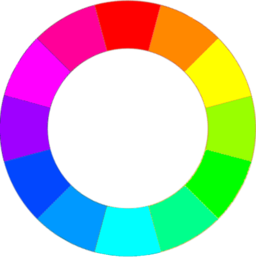This paint Color Schemes for Houses selection guide will help you with paint color ideas, choosing paint color, and select the ideal paint color scheme for your room.

The color wheel is a way of ordering colors into certain groups (hot or cool et cetra), with the three primary colors being equally spaced around the wheel. Those colors considered in the “hot” half would be pink, red, orange, and some yellows, and those considered “cool” would be the purple, blue, green, and paler yellows.
When choosing whether to have a “hot” or “cool” main paint color in a room, think about which direction the windows face. East-facing windows, that let in early morning sun, benefit from warm colors, whereas a west-facing room favors the use of a cool, light scheme. With this in mind, pick up any paint chips that you are drawn to in the store, and see how they look in your room, as light alters at different times of the day.
If you are still stuck for paint color ideas for a room, then look around. If there’s a couch you really love that is be part of the scheme then choose that as a main, or accent, color for the room. Even if there’s something really small, like a vase, or a cushion that you just had to have, use this as the focal starting point, and go from there, to choose your overall paint color schemes for houses.
With paint color ideas in mind, and using the color wheel as a guide, you can create numerous different paint color schemes for houses. Use a combination of colors, or a single color, and vary the shades. There are three basic schemes to be considered when decorating:
A monochromatic paint color schemes for houses is based around one color. It sounds dull, but the trick is to use varying shades and intensities of a single color. The monochromatic color schemes for houses works well anywhere, but is ideally suited to smaller rooms that would be overwhelmed by the use of too many colors. Remember to use lots of different shades of the color, and use texture and pattern to break up any monotony. Using black, white, and grey as accents is obviously acceptable.
A harmonious paint color schemes for houses uses colors that are next to each other on the color wheel. Select the main color, and then choose one color next to it on the color wheel, as a supporting color – example: orange and yellow. Or, select your main color to dominate, and then one from either side – a second color as support, and a third as an accent color. Examples of this type of color scheme would be: green, blue and yellow; or red, purple and blue.
When using a harmonious color schemes for houses, it is not ideal to stray any further from your main color than one color away on the color wheel. Bear in mind, the overall effect should be harmonious and pleasing to the eye – often the kind of scheme found in nature.
A complementary paint color schemes for houses uses two colors that are on opposite sides of the color wheel from each other – example: yellow and purple. These colors create a vibrant look together, but a lot of consideration must go into this color scheme to make it work.
If this scheme seems overwhelming, try using more muted shades of your chosen colors, such as pale yellow and lilac, rather than full on yellow and purple.
Try using one of the colors as the main color, and the complementary color in smaller quantities as an accent color. Think of a green couch with red cushions or a purple vase against a yellow wall.
Using the colors in this scheme at equal color intensity levels is also very important. While pale yellow and lilac look great together, using pale yellow with a vibrant purple may not, as the yellow would be lost in the scheme, rather than featured as a lively accent color.
There are other more involved ways of creating a paint color schemes for houses using the color wheel, but by using this paint color selection guide, you’ll be creating professional looking color schemes for houses with ease.
Although underlayment is used during the construction of virtually every home in the world, many…
Maximize every inch with purpose-built shelving—tailored for beauty, space efficiency, and seamless design integration.
Glass partitions and doors bring a gloss and style to virtually any interior, from minimalistic…
Managing residential properties is integral to real estate as it ensures that the investment is…
Explore top bathroom taps: mixer, automatic & single-lever faucets. Upgrade for style & efficiency with…
Low water pressure in the house can be more than just a minor inconvenience; it…
View Comments